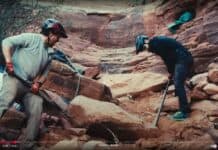As the complaints about traffic rise, so do the same tired arguments that abolishing the Sedona Chamber of Commerce or somehow banning tourists will fix all our problems.
So let’s imagine the first scenario, that the chamber suddenly dissolved tomorrow.
 Sedona area resorts, restaurants and businesses would still heavily advertise to tourists on their own and some would even increase their efforts. Their advertising efforts channeled through the chamber are small components of their overall marketing budgets, as most advertise themselves to potential out-of-the-area customers via other means.
Sedona area resorts, restaurants and businesses would still heavily advertise to tourists on their own and some would even increase their efforts. Their advertising efforts channeled through the chamber are small components of their overall marketing budgets, as most advertise themselves to potential out-of-the-area customers via other means.
A resort, for instance, supports the chamber’s efforts to bring tourists to the whole Sedona area in the hope that a percentage of those visitors attracted by the chamber’s destination marketing may choose to stay at that particular resort, but that resort doesn’t make any money if a visitor stays elsewhere.
Thus, that resort also invests heavily in its own marketing efforts to attract tourists specifically to its property in Sedona so that it can earn profit on the room instead of one of its competitors.
Restaurants and retail shops do the same thing, collectively trying to attract visitors via the chamber but maintaining their own marketing to draw customers to their particular location.
Redrocknews.com ads, Facebook, TripAdvisor, Yelp and FourSquare still have tens of thousands of posts, reviews, ads and recommendations on the internet, and would still remain, aiming to attract customers at the same ferocity as before the chamber disappeared.
Let’s run a thought experiment on the second scenario: Visitors simply ceased coming — imagine Sedona renamed itself “Schnebly Station,” as founder T.C. Schnebly first proposed in 1902, and tourists could no longer find our city on the map.
With 3 million tourists per year, we have on average 8,219 people in town per day, nearly all of whom dine out. At most, our 10,000 residents dine out two or three times a week, meaning about 4,100 are looking for a restaurant meal on an average day. We have roughly 90 restaurants in town, so with a loss of two-thirds of customers, pick 60 at random to close.
Close every resort and all but three hotels. Close Tlaquepaque, Hillside Sedona, Hozho Plaza, every shop and store in Uptown and all but two art galleries.
The median home value in Sedona is $443,500, according to Zillow. With no tourists who fall in love with Sedona and want to move here, housing prices fall in line with those in Cottonwood, which has a median home value of $209,600, also per Zillow, so calculate the value of your home and reduce it by 53 percent. If you own a second home converted into a vacation rental, erase that income.
With no tourism-driven economy, commercial rents drop even further, by about 75 to 80 percent, in line with commercial spaces elsewhere in the Verde Valley. Walmart and Target begin eyeing property to buy.
With all those businesses closed and nowhere for service industry employees to work in town, reduce the number of residents by about 40 percent.
We have five thrift stores in Sedona and the Village of Oak Creek. Pick three at random to close. Sedona has four major grocery stores. Pick two at random to close. Sedona has roughly 160 nonprofits that function daily. Reduce that at random to 30. The Sedona International Film Festival is gone, the Mary D. Fisher Theatre closes and the Sedona Performing Arts Center is only used for school activities, not third-party rentals. With drastically lower property values, reduce the number of teachers by 30 percent and combine classes.
Reduce our numerous festivals and citywide events to two, both run by the city: The St. Patrick’s Parade and the Holiday Tree Lighting.
With no tourists, the city’s sales tax revenue also drops, so reduce the number of police officers, shut down either Posse Grounds Park or all the other city parks, and don’t expect potholes to get fixed for at least five years, when the city can afford to reach your street. If you’re not yet on the city sewer line, don’t expect to ever be. To keep the city functioning at minimal levels, get ready for a municipal property tax.
With fewer bodies in town and lower property values, reduce the number of firefighters, paramedics and ambulances by 50 percent. Double the time it takes to respond to your medical emergency.
Banning tourists makes for great rhetoric on social media but makes no sense when logically explored.
Christopher Fox Graham
Managing Editor

















